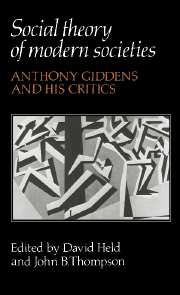Book contents
- Frontmatter
- Contents
- List of contributors
- List of abbreviations
- Editors' introduction
- 1 Social theory as critique
- 2 Hermeneutics and modern social theory
- 3 The theory of structuration
- 4 Models of historical trajectory: an assessment of Giddens's critique of Marxism
- 5 Capitalism, nation-states and surveillance
- 6 War and the nation-state in social theory
- 7 Only half the story: some blinkering effects of ‘malestream’ sociology
- 8 Citizenship and autonomy
- 9 Presences and absences: time–space relations and structuration theory
- 10 Space, urbanism and the created environment
- 11 On the (ir)relevance of structuration theory to empirical research
- 12 A reply to my critics
- Select bibliography
- Index
9 - Presences and absences: time–space relations and structuration theory
Published online by Cambridge University Press: 24 November 2009
- Frontmatter
- Contents
- List of contributors
- List of abbreviations
- Editors' introduction
- 1 Social theory as critique
- 2 Hermeneutics and modern social theory
- 3 The theory of structuration
- 4 Models of historical trajectory: an assessment of Giddens's critique of Marxism
- 5 Capitalism, nation-states and surveillance
- 6 War and the nation-state in social theory
- 7 Only half the story: some blinkering effects of ‘malestream’ sociology
- 8 Citizenship and autonomy
- 9 Presences and absences: time–space relations and structuration theory
- 10 Space, urbanism and the created environment
- 11 On the (ir)relevance of structuration theory to empirical research
- 12 A reply to my critics
- Select bibliography
- Index
Summary
Introduction
In this chapter I consider the incorporation of time–space relations within structuration theory: the way in which Giddens conceives of what he calls the time–space constitution of social life. There are obvious dangers in disentangling one thread from such a dense and developing argument, and so I want to begin by putting some limits around my own discussion.
A number of commentators are evidently uncomfortable about the status of structuration theory. They claim that its first formulations were pitched at forbidding heights of abstraction, whereas its later arguments have moved towards a more concrete terrain. In consequence, they say, it has become difficult to determine the scope of structuration theory with any precision. In my view, however, it makes most sense to treat Giddens's writings as a research programme developed through a continuous dialogue between the theoretical and the empirical. The term derives from Lakatos, of course, but I use it in a somewhat different sense because Giddens's project is not linear: one proposition does not succeed another in a unidimensional, unidirectional sequence. What I have in mind is closer to Hesse's network model of science. Structuration theory then appears as a loose-knit web of propositions, some more central than others, some spun more tightly than others. In contradistinction to networks in the natural sciences, structuration theory is clearly not directed towards the discovery of ‘laws’; but, as Hesse suggests more generally, its development has been determined – though less formally than some of its critics seem to think – by both coherence rules (relating to the structure of the network) and correspondence rules (relating to empirical observations).
- Type
- Chapter
- Information
- Social Theory of Modern SocietiesAnthony Giddens and his Critics, pp. 185 - 214Publisher: Cambridge University PressPrint publication year: 1989
- 32
- Cited by



